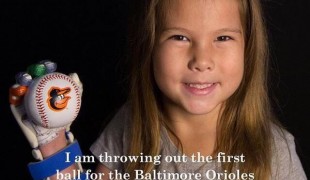- 7061
- 483
- 10
- 10
- 0
- Help Ukraine
About the solution
The wires in the bands would connect to sensors on the chest which, when fired by the brain, contract the muscles and contract the band associated with that muscle.
The Robotic Arm is intended for use by sufferers of muscular and neural problems including muscular dystrophy, Parkinson’s disease, ALS and more.
Unlike a traditional robotic arm, this device fits like a sock over the existing arm of the wearer. It has retracting bands that move the wearer’s arms and hands about. The idea is to help people with their day to day activities such as eating and shopping. In case of a malfunction, the Robotic Arm is programmed to switch off and relax the wearer’s own arm.
“My mum’s friend had muscular dystrophy and when I asked her what the worst part of it was, she said it was that she couldn’t hug her daughter,” Mia said.
“I thought there should be something we could do about it.
“I had a few ideas before that but I didn’t think they were good enough, then I came up with this idea late at night.”
Mia’s robotic arm entry was chosen along with Year 7 and 8 student entries demonstrating originality, creativity, practicality, imagination and innovation.
Mia was a finalist in Origin’s littleBIGidea competition.
Adapted from: http://bit.ly/2g0Vv8g
What about you, do you have any solutions? Please share them with the Patient Innovation community!
https://www.youtube.com/watch?v=LtXn7Fk04G8
This solution shall not include mention to the use of drugs, chemicals or biologicals (including food); invasive devices; offensive, commercial or inherently dangerous content. This solution was not medically validated. Proceed with caution! If you have any doubts, please consult with a health professional.
DISCLAIMER: This story was written by someone who is not the author of the solution, therefore please be advised that, although it was written with the utmost respect for the innovation and the innovator, there can be some incorrect statements. If you find any errors please contact the patient Innovation team via info@patient-innovation.com
-
-
369
-
2
-
4023

Students make 3D printed hand and arm for a little girl
Grip
CAREGIVING
Muscle Tone Abnormalities
Muscular Dystrophy
3d Printed
Assistive Daily Life Device (to help ADL)
Prosthesis
Muscle cramps or spasms
Stiffness or rigidity (difficulty moving)
Muscle weakness
Promoting self-management
Preserving Organ Function
Promoting inclusivity and social integration
Raise awareness
Medical Genetics
Neurology
Orthopedics
Rheumatology
United States
-
-
-
512
-
0
-
7368

Scooter for disabled people
MOVING IN A WHEELCHAIR: Moving using a wheelchair.
CAREGIVING
Amyotrophic Lateral Sclerosis
Assistive Daily Life Device (to help ADL)
Walking Aid (wheelchair/walker/crutches)
Gait abnormalities (e.g., walking difficulties, unsteady gait)
Muscle cramps or spasms
Difficulty coordinating movements
Stiffness or rigidity (difficulty moving)
Paralysis of the legs and lower body
Muscle weakness
Fatigue
Restoring mobility
Promoting self-management
Rehabilitating After Stroke
Managing Neurological Disorders
Promoting inclusivity and social integration
Preventing (Vaccination, Protection, Falls, Research/Mapping)
Caregiving Support
Neurology
Orthopedics
Rheumatology
United States
-
-
-
547
-
0
-
8930

Man creates device to help to put on socks, shoes and even trousers
Grip
(SELF)-CARE: DRESSING: Dressing independently.
BODY BALANCE: Maintaining body balance
STANDING UP: Standing up from a seated position
Knee Deformity
Assistive Daily Life Device (to help ADL)
Strategy/Tip
Muscle weakness
Limited range of motion
Muscle pain or stiffness
Reduced grip force (grip)
Loss of muscle coordination
Muscle cramps or spasms
Joint deformity
Joint redness or warmth
Swelling or inflammation
Difficulty bearing weight
Muscle twitching
Difficulty standing from a seated position
Difficulty getting up from the floor
Numbness or tingling in the extremities
Joint pain or swelling
Restoring mobility
Promoting self-management
Preserving Organ Function
Rehabilitating After Stroke
Managing Neurological Disorders
Recovering from Traumatic Injuries
Maintaining Balance and Mobility
Preventing (Vaccination, Protection, Falls, Research/Mapping)
Caregiving Support
Internal Medicine
Neurology
Orthopedics
Physical Medicine and Rehabilitation
Rheumatology
Sports Medicine
Vascular Surgery
United States
-
 en
en